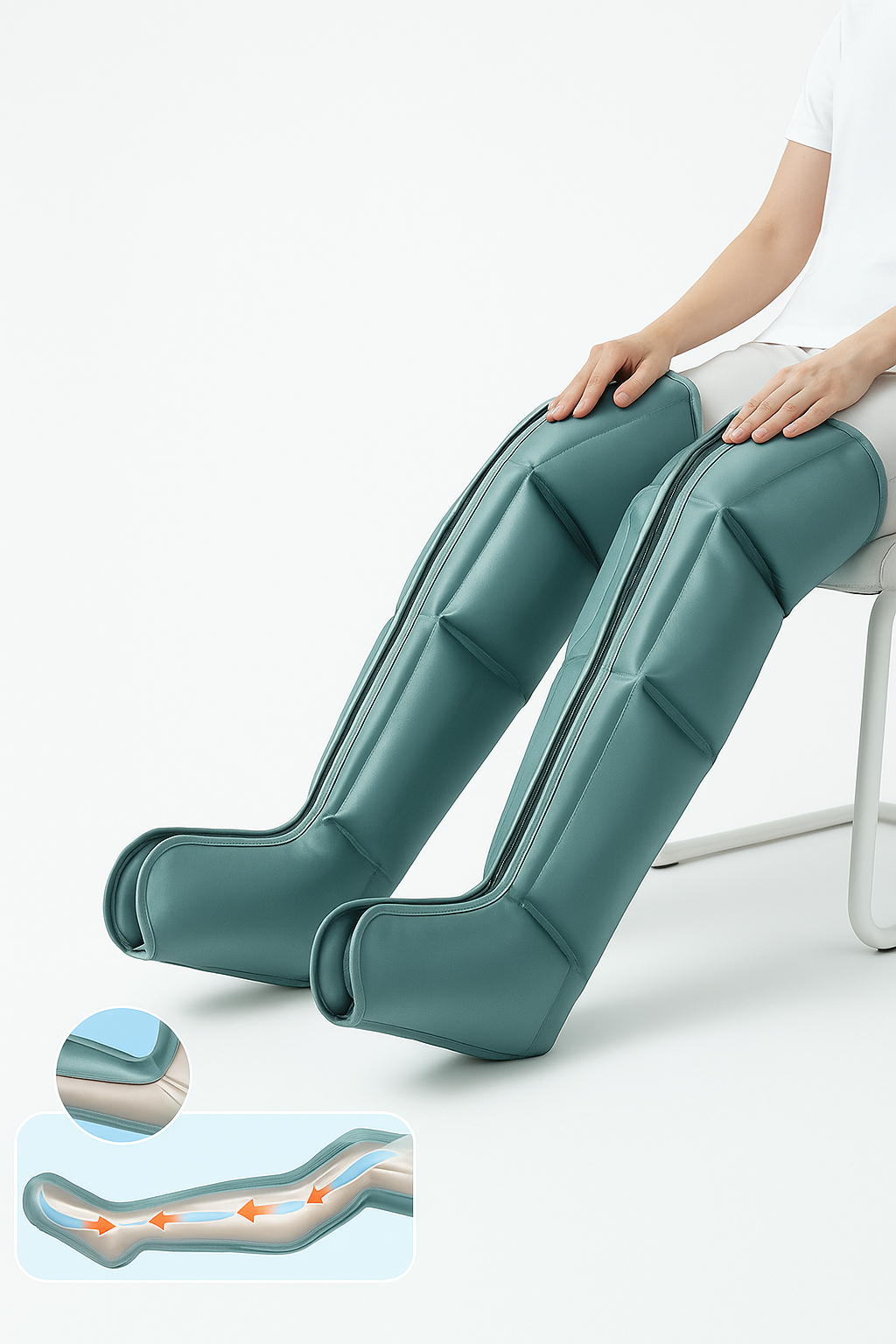혈액 순환 개선 및 정맥 회류 향상
공압 압축 요법이 다리의 혈류를 증가시키는 원리
압축 공기를 사용하는 다리 마사지기는 순차적으로 압력을 가하여 근육이 자연스럽게 수축하는 것을 모방합니다. 이는 산소가 풍부한 혈액을 동맥을 통해 밀어내고 다리에서의 정맥혈 회류 속도를 높입니다. 이러한 작용은 중력으로 인해 혈액이 정체되는 현상에 대항하는 데 도움이 되며, 장시간 앉아 있는 사람이나 순환 장애가 있는 많은 사람들에게 유익합니다. 2022년 <네이처>에 발표된 연구에 따르면, 이러한 마사지기는 아무것도 하지 않고 가만히 있는 것과 비교했을 때 종아리 정맥의 혈류를 약 37% 증가시킵니다. 따라서 장시간 일하거나 집에서 앉아 지낸 후 움직임이 제한되거나 혈액 순환을 추가로 돕고자 하는 사람들에게 매우 유용합니다.
정맥혈 회류 개선이 다리 피로와 부종 감소에 미치는 역할
이러한 장치는 심장으로 돌아가는 혈류를 개선함으로써 세포 사이의 조직에서 발생하는 대부분의 부종 부위에 체액이 고이는 것을 줄이는 데 도움을 줍니다. 오랫동안 앉아 있거나 서 있는 사람들을 대상으로 한 연구에 따르면, 하루에 단지 20분 동안 이러한 치료를 받으면 다리 부종이 약 29% 감소할 수 있습니다. 혈액 순환이 개선되면 젖산과 같은 노폐물도 근육에서 더 빠르게 제거됩니다. 이는 다리의 무거운 느낌을 덜어줄 뿐 아니라 바쁜 하루를 마무리할 때 많은 사람들이 겪는 뻐근하고 뻣뻣한 증상을 완화시켜 줍니다.
사례 연구: 비활동적인 생활 방식을 가진 개인들의 순환 개선
주 5회 다리 마사지기를 사용한 사무직 종사자를 대상으로 한 12주간의 임상 시험 결과:
- 다리 무거움 감각 22% 감소 (VAS 척도)
- 족부-상완 혈압지수(ABI) 점수 18% 향상
- 야간 다리 경련 발생률 31% 감소
이러한 결과들은 비복정맥의 혈류 속도가 초음파 검사를 통해 확인된 증가와 일치하며, 측정 가능한 혈역학적 개선을 입증합니다.
트렌드 분석: 순환 건강을 위한 공기 압축 기술 채택 증가
원격 근무 트렌드와 고령화 인구의 영향으로 2020년부터 2023년까지 기계식 다리 압축 장치에 대한 수요가 140% 증가했다(Ponemon, 2023). 현재 정맥 전문의의 83%는 초기 단계 정맥 부전 치료 시 보조 요법으로 압축 요법을 권장하고 있으며, 그 비침습성과 입증된 혈액순환 개선 효과를 이유로 들고 있다.
근육 회복 속도 향상 및 운동 후 통증 감소
타겟형 압축을 통한 지연성 근육통(DOMS) 완화
공기 압축을 사용하는 다리 마사지기는 DOMS(과도한 운동 후 근육이 뻣뻣하고 아픈 현상)를 완화하는 데 도움을 줍니다. 2016년의 일부 연구에서는 울트라마라톤을 한 사람들을 조사한 결과 흥미로운 사실을 발견했습니다. Hoffman과 동료들의 연구에 따르면, 압박 요법을 사용한 사람들은 치료를 받지 않은 다른 사람들에 비해 근육 통증이 약 38퍼센트 덜하다고 보고했습니다. 여기서 일어나는 과정은 실제로 매우 흥미롭습니다. 이러한 장치들은 운동 중 근육이 자연스럽게 수축하는 방식과 유사하게 다리를 순차적으로 압박합니다. 이 과정을 통해 피로한 근육에 축적된 젖산 같은 노폐물을 배출하고 산소가 풍부한 신선한 혈액을 가장 필요한 부위로 공급하게 됩니다.
혈류 개선 및 염증 감소를 통한 회복 속도 가속화
이러한 회복 장비는 심장으로의 혈류를 증가시키고 림프액이 신체 내에서 원활하게 이동하도록 도와주어, 샌즈와 동료들이 2015년에 발표한 연구에 따르면 운동 후 염증을 약 21% 정도 감소시킬 수 있습니다. 혈액 순환이 개선되면 근육 내 노폐물이 더 빠르게 제거되기 때문에 사람들은 평소보다 더 빨리 회복됩니다. 예를 들어 고강도 훈련을 하는 운동선수들의 경우, 회복 과정에서 압축 의류를 착용하면 단 하루 만에 거의 모든 초기 근력으로 돌아오는 것을 경험하는 반면, 아무런 조치 없이 단순히 휴식만 취하는 사람들은 동일한 기간 동안 운동 전 능력의 약 72% 정도만 회복하는 것으로 나타났습니다.
근육 회복 및 성능 유지에 대한 과학적 근거
근육 보존에 대한 연구에서 공기 압축이 회복 기간 동안 근육 기능 유지에 실제로 도움이 된다는 것이 밝혀졌다. 최근의 종합 분석에서 다양한 연구들을 함께 검토한 결과, 압축 요법을 사용한 운동선수들은 그렇지 않은 선수들보다 힘 발휘가 약 27% 더 빠르게 회복된 것으로 나타났다. 작년에 '스포츠 의학 저널(Journal of Sports Medicine)'에 발표된 MRI 결과를 살펴보면 이 사실은 더욱 흥미롭다. 이러한 영상 촬영 결과, 압축 치료 세션 후 대퇴사두근의 미세한 파열이 적게 나타났다. 그리고 이것은 단순한 이론적 이점에 그치지 않으며, 실제로 이러한 운동선수들의 스프린트 성능이 이후 약 15% 향상되었다.
논란 분석: 압축 요법이 운동 회복에서 과대평가되고 있는가?
지지자들은 이 방법이 얼마나 비침습적인지에 대해 이야기하는 것을 좋아하지만, 일부 회의론자들은 2021년 코크레인 연구에 따르면 사람들이 더 나아졌다고 보고하는 효과의 약 3분의 1에서 거의 절반 정도는 단지 위약 효과일 수 있다고 지적합니다. 그러나 이를 뒷받침하는 실제 과학적 근거도 존재합니다. 숫자는 흥미로운 점을 보여주는데, 압박을 받는 근육은 그렇지 않은 근육보다 젖산을 약 19% 더 빠르게 제거하는 경향이 있습니다. 따라서 어떤 사람들은 이러한 제품만 착용해도 큰 효과를 본다고 주장하지만, 연구에 따르면 다른 입증된 방법들과 함께 적절한 회복 루틴의 일환으로 사용할 때 가장 효과적이며, 오로지 이것만에 전적으로 의존하는 것보다는 통합적으로 활용하는 것이 좋습니다.
부기 및 염증 감소와 림프 지원
다리와 발의 체액 축적 및 부종 감소
공기 압축 다리 마사지기는 자연스러운 근육 펌프 작용을 모방하는 순차적 압력 파동을 통해 체액 축적을 완화합니다. 이 메커니즘은 과도한 간질액을 순환계로 다시 분배함으로써 부종을 직접적으로 완화시킵니다. 2022년의 임상 리뷰에 따르면, 신체 활동이 제한된 집단에서 꾸준히 사용할 경우 하지 부종의 심각도가 32% 감소했습니다.
공기 압축 방식이 림프 배출 및 노폐물 제거를 어떻게 향상시키는가
림프계는 노폐물을 운반하기 위해 외부 압력 기울기에 의존하며, 공압 압축의 리듬 있는 사이클에 의해 이 과정이 강화됩니다. 연구에 따르면 이러한 장치는 정적 압축 방법 대비 림프 유속을 27% 증가시켜 C-반응성 단백질과 같은 염증 생체지표의 제거를 가속화합니다.
사례 연구: 다리 마사지기의 정기적 사용을 통한 만성 부종 관리
최근 한 연구에서 만성 부종 환자들을 9주 동안 추적 관찰한 결과, 하루 30분씩 매일 치료를 받은 환자들의 다리 부피가 평균적으로 약 18% 감소한 것으로 나타났다. 임상 시험에 참여한 사람들은 또한 다리의 조임 증상이 41% 정도 줄어들었다고 보고했으며, 피로감 없이 걷는 시간이 약 22% 증가했다. 흥미로운 점은 치료를 중단한 지 6주 후에도 이러한 개선 효과가 유지되었다는 것이다. 더 큰 범위의 연구 결과를 살펴보면, 이는 압력 순환 요법이 전체 사례의 약 80%에서 수기 림프 배액과 동일한 수준으로 부기를 감소시킨다는 기존 인식을 뒷받침한다. 최근 점점 더 많은 클리닉에서 이러한 접근 방식을 도입하고 있는 이유가 여기에 있다.
노년층 및 비활동성 사용자를 위한 통증 완화, 운동 능력 향상 및 건강 증진
다리 마사지기는 통증 관리와 움직임의 향상을 원하는 사람들, 특히 고령층 및 사무실에서 오래 앉아 있거나 장시간 서서 일하는 직업군에 종사하는 사람들에게 획기적인 혜택을 제공합니다. 이러한 기기들은 다양한 웰니스 니즈를 해결하기 위해 특정 부위를 집중적으로 압축하고 압력 세기를 조절할 수 있는 기능을 결합하고 있습니다.
일상생활에서 뻣뻣함 완화 및 운동 범위 개선
공기압 압박 요법은 다리를 쥐었다 폈다 반복하는 동작을 통해 완고한 근육 경직을 해소하는 데 도움이 됩니다. 흥미로운 점은 이러한 압력 변화가 신체의 관절 윤활 작용을 촉진하여, 계단을 오르거나 바닥에 있는 물건을 집으려고 앉는 것처럼 매일 당연하게 여기는 동작을 할 때 움직임이 훨씬 더 부드러워진다는 것입니다. 이 요법을 꾸준히 받은 사람들을 대상으로 한 연구에 따르면, 3주 남짓 꾸준히 사용한 사람들은 일상생활이 훨씬 수월해지는 것을 약 3분의 1 정도 느끼는 것으로 나타났습니다.
장시간 서 있거나 앉아 있는 사람들을 위한 지원
순차적 압축 패턴은 장기간 움직이지 않음으로 인해 발생하는 체액 축적을 방지합니다. 2021년의 한 연구에 따르면, 하루 두 번 레그 마사저를 사용한 근로자는 단지 휴식만 취한 그룹보다 하지 부종이 42% 적게 나타났습니다. 리듬감 있는 압력은 신체 활동 없이도 자연스러운 근육 수축을 모방하여 정맥혈 회류를 돕습니다.
노년층을 위한 이점: 통증 감소 및 운동 능력 향상
나이가 들면서 순환 기능이 저하되면 관절 퇴행과 불편함이 유발됩니다. 류마티즘 분야 임상시험에 따르면, 65세 이상 사용자의 경우 공기압축 장치를 통해 골관절염 관련 통증이 37% 감소했습니다. 혈류 개선은 연골에 더 많은 산소를 공급하고 염증 유발 대사산물을 제거함으로써 장기적인 관절 건강을 지원합니다.
스포츠 외의 웰니스 활용: 임상 및 비활동성 환경에서의 사용
물리치료사들은 점점 더 뇌졸중 환자와 관절 치환 수술 후 환자의 재활 프로토콜에 다리 마사지기를 포함시키고 있다. 기업 웰니스 프로그램에서는 사무직 근로자들이 휴식 시간에 압축 요법을 사용할 경우 근골격계 불만이 28% 적게 발생한다고 보고하고 있다. 임상 환경과 일상 환경 모두에서의 이러한 이중 활용성은 공기압 압축 요법을 예방 의료 분야에서 유용한 도구로 자리매김하게 한다.
자주 묻는 질문
공기압 다리 마사지기를 사용하는 것의 장점은 무엇인가요?
공기압 다리 마사지기는 혈액 순환을 개선하고, 부기와 염증을 줄이며, 림프 배출을 촉진하고, 근육 회복 속도를 높이므로 오래 앉아 있거나 운동하는 사람들에게 이상적입니다.
누가 공기압 압축 요법의 혜택을 볼 수 있나요?
오랫동안 앉아 있거나 서 있는 사람, 노인, 운동선수 및 순환 문제를 가진 사람들은 공기압 압축 요법으로부터 상당한 혜택을 얻을 수 있습니다.
최상의 결과를 위해 다리 마사지기를 얼마나 자주 사용해야 하나요?
매일 적어도 20-30분 이상 다리 마사지기를 사용하면 다양한 연구에 따르면 부기 감소, 혈액 순환 개선 및 근육 회복 촉진에 최적의 효과를 얻을 수 있습니다.
압축 요법이 운동 후 근육 통증 완화에 효과가 있나요?
예, 압축 요법은 혈액 순환을 개선하고 염증을 줄임으로써 회복 속도를 높여 운동 후 근육 통증 감소에 매우 효과적입니다.
공기압 마사지 요법에 알려진 부작용이 있나요?
공기압 마사지 요법은 일반적으로 안전하지만, 특정 의학적 상태를 가진 사람은 사용 전 의료 제공자와 상의해야 합니다.




